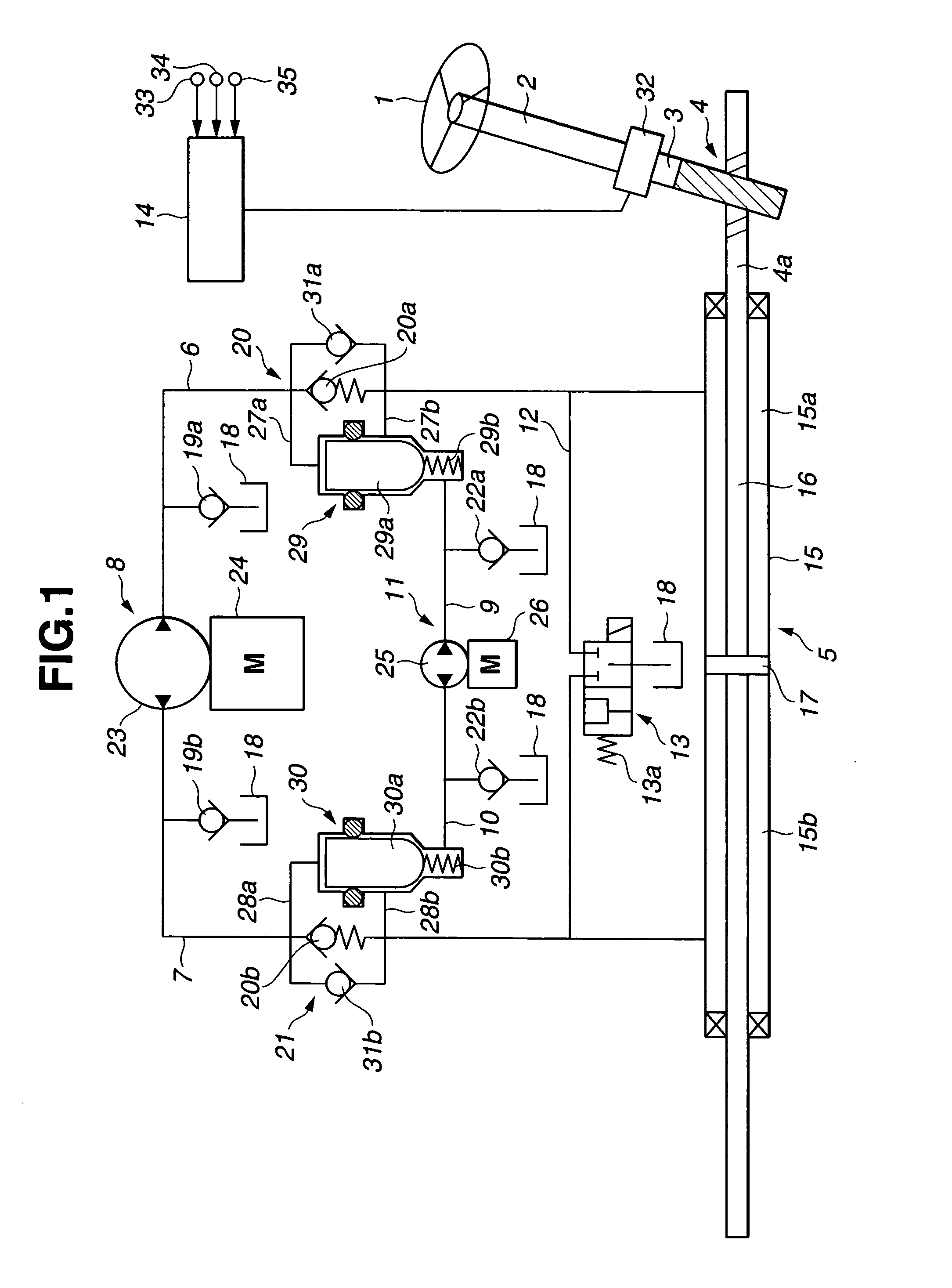Power Steering Device and Method of Controlling the Power Steering Device
a technology of power steering and power steering device, which is applied in the direction of steering initiation, instruments, vessel construction, etc., can solve the problems of large steering force to be produced by the driver, insufficient steering assist force, and inability to make positive steering assist during manual steering mod
- Summary
- Abstract
- Description
- Claims
- Application Information
AI Technical Summary
Benefits of technology
Problems solved by technology
Method used
Image
Examples
first embodiment
[0053]FIG. 1 schematically shows the power steering system of the first embodiment. The system of the first embodiment is mainly comprised of a steering shaft 2 to which a steering wheel 1 is fixedly connected, a rack-and-pinion mechanism 4 serving as a steering mechanism (a steering gear mechanism) installed on an output shaft 3 linked to a lower end of steering shaft 2, a hydraulic power cylinder 5 provided to render assistance to a driver's operating force applied to the steering wheel, a first hydraulic pressure supply mechanism 8 serving as the first hydraulic pressure supply means for selectively supplying working fluid pressure to hydraulic power cylinder 5 via either one of first and second fluid passages 6 and 7, a second hydraulic pressure supply mechanism 11 arranged parallel to first hydraulic pressure supply mechanism 8 and serving as the second hydraulic pressure supply means for selectively supplying working fluid pressure to hydraulic power cylinder 5 via either one ...
second embodiment
[0177]Referring now to FIG. 15, there is shown the system of the second embodiment. The second embodiment is different from the first embodiment in that, in the second embodiment, the capacities of second electric motor 26 and second trochoid pump 25 of second hydraulic pressure supply mechanism 11 are set to the same capacities as those of first hydraulic pressure supply mechanism 8.
[0178]Second hydraulic pressure supply mechanism 11 of the second embodiment is constructed in a manner so as to operate together with first hydraulic pressure supply mechanism 8 during operation as well as during a failure in the first hydraulic pressure supply mechanism. The sum of maximum discharge capacities of first and second hydraulic pressure supply mechanisms 8 and 11 of the second embodiment is set to be substantially identical to the maximum discharge capacity of first hydraulic pressure supply mechanism 8 of the first embodiment. The discharge capacity of each of the first and second hydraul...
third embodiment
[0185]Referring now to FIG. 17, there is shown the system of the third embodiment, wherein communication passage 12 and fail-safe valve 13 are eliminated.
[0186]Therefore, when first and second hydraulic pressure supply mechanisms 8 and 11 are both failed, it is impossible to provide a fail-safe valve function. This leads to the problem of a great driver's operating load on steering wheel 1, but realizes greatly-reduced production costs.
[0187]The method of failure detection performed during a system failure, such as a failure in at least one of equipments constructing the power steering system of the third embodiment, is identical to that of the first embodiment. In the system of the third embodiment the fail-safe valve is eliminated and therefore the failure-detection method (the other failure-detecting stages) except the first stage S1 is applied to the third embodiment.
PUM
 Login to View More
Login to View More Abstract
Description
Claims
Application Information
 Login to View More
Login to View More - R&D
- Intellectual Property
- Life Sciences
- Materials
- Tech Scout
- Unparalleled Data Quality
- Higher Quality Content
- 60% Fewer Hallucinations
Browse by: Latest US Patents, China's latest patents, Technical Efficacy Thesaurus, Application Domain, Technology Topic, Popular Technical Reports.
© 2025 PatSnap. All rights reserved.Legal|Privacy policy|Modern Slavery Act Transparency Statement|Sitemap|About US| Contact US: help@patsnap.com



